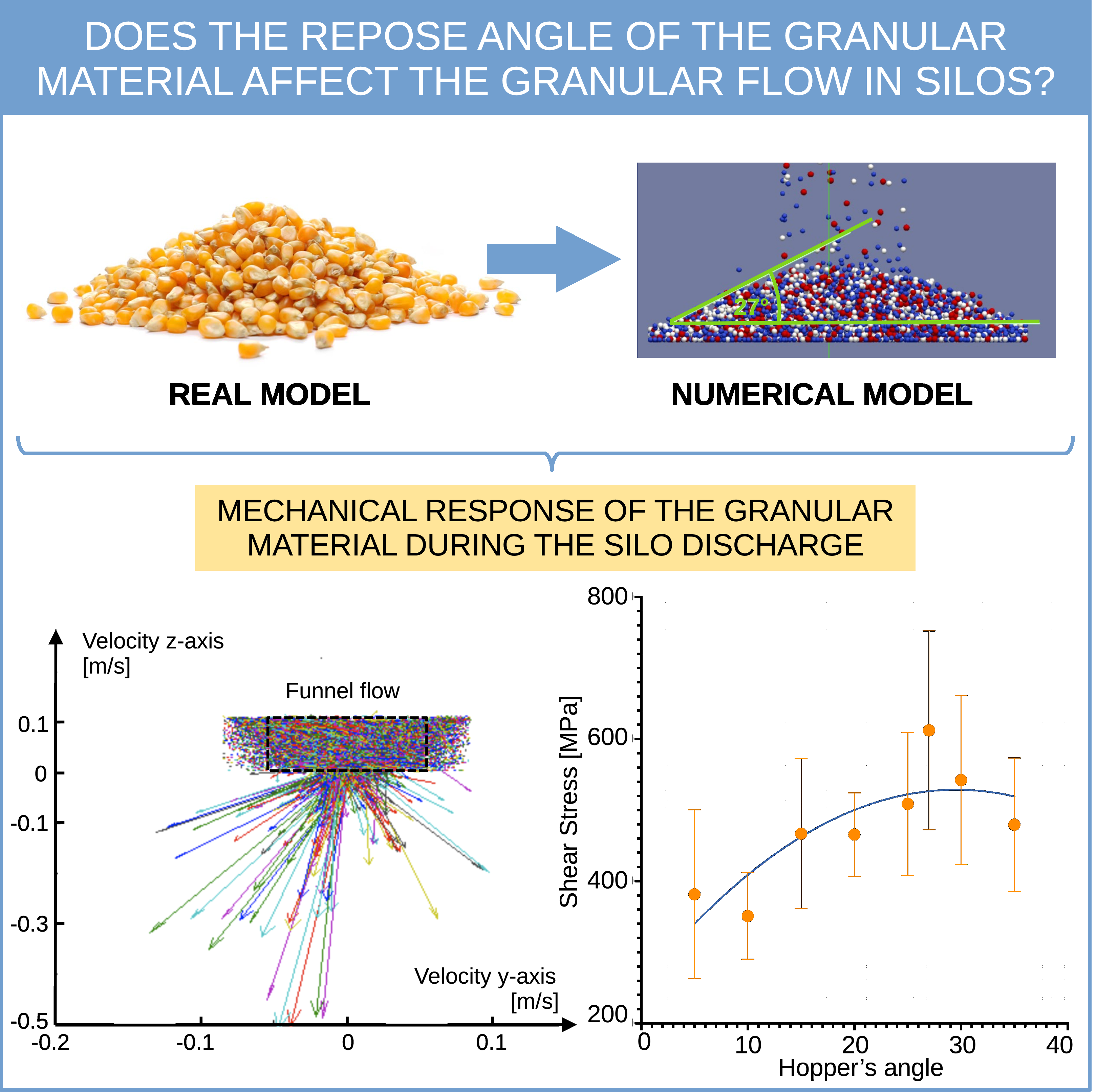Estudio Paramétrico del Flujo Granular en Silos: Una Aproximación Micro-Mecánica
##plugins.themes.bootstrap3.article.main##
Resumen
El estudio del material granular almacenado en silos se lo ha realizado habitualmente con las formulaciones de la mecánica del medio continuo y los elementos finitos. Sin embargo, existen diversas limitaciones al cuantificar la interacción entre partículas y su comportamiento individual. Por lo tanto, se plantea la utilización del método del elemento discreto (DEM) para evitar las limitaciones intrínsecas de modelos continuos en el análisis del flujo de maíz (materia granular) durante los procesos de descarga en silos. El elemento discreto es una eficaz herramienta mecánico-computacional que permite modelar ensambles granulares al considerar sus propiedades físicas y mecánicas tanto al nivel individual como de conglomerado. En esta investigación, los ensambles diseñados son representaciones numéricas de granos de maíz almacenado en silos. Los resultados de las simulaciones se cuantifican en términos de perfiles de velocidad, cadenas de fuerza, esfuerzos en las paredes del silo, y deformaciones del conglomerado granular. Uno de los principales hallazgos de esta investigación es la importancia del ángulo de reposo del maíz en la descarga de silos ya que los esfuerzos, deformaciones y cadenas de fuerza varían dependiendo de este valor (27°).
Descargas
Descargas
Detalles del artículo
Citas
Andrade, J. E., Lim, K.-W., Avila, C. F., & Vlahini´c, I. (2012). Granular element method for computational particle mechanics. Computer Methods in Applied Mechanics and Engineering, 241–244, 262–274. https://doi.org/10.1016/j.cma.2012.06.012
Avila, C., & Andrade, J. (2012). Advances in multiscale modeling and characterization of granular matter. Procedia IUTAM, 3, 157–171. https://doi.org/10.1016/j.piutam.2012.03.011
Baars, S. Van. (1995). Discrete element modelling of granular materials [Delft University of Technology]. https://repository.tudelft.nl/islandora/object/uuid%3A9ccd2776-6cd4-4536-b827-7feb49fda7bb
Babié, M. (1988). Discrete Particle Numerical Simulation of Granular Material Behavior [Clarkson University]. https://lin-web.clarkson.edu/~hhshen/teaching%20links/DEM%20document.pdf
Benyamine, M., Aussillous, P., & Dalloz-Dubrujeaud, B. (2017). Discharge flow of a granular media from a silo: effect of the packing fraction and of the hopper angle. EPJ Web of Conferences, 140(January), 03043. https://doi.org/10.1051/epjconf/201714003043
Boac, J. M. (2010). Quality changes, dust generation, and commingling during grain elevator handling [Kansas State University]. https://krex.k-state.edu/bitstream/handle/2097/2373/JosephineBoac2010.pdf?sequence=3&isAllowed=y
Brown, J. (2007). Numerical analysis of silo discharge [LUND University]. https://www.byggmek.lth.se/fileadmin/byggnadsmekanik/publications/tvsm5000/web5151.pdf
Cundall, P. A., & Strack, O. D. L. (1979). A discrete numerical model for granular assemblies. Géotechnique, 29(1), 47–65. https://doi.org/10.1680/geot.1979.29.1.47
Elaskar, S., & Godoy, L. (2001). Simulación numérica del flujo de materiales granulares usando el concepto de estado crítico. Revista Internacional de Métodos Numéricos Para Cálculo y Diseño En Ingeniería, 17(1), 19–36. https://upcommons.upc.edu/bitstream/handle/2099/3382/RR171B.pdf?sequence=1&isAllowed=y
Fernández, D. (2010). Determinación de parámetros utilizados en las simulaciones d.e.m. [Universidad Politécnica de Madrid]. https://oa.upm.es/10514/2/TESIS_MASTER_DANIEL_FERNANDEZ_LLANA.pdf
Goodman, M. A., & Cowin, S. C. (1972). A continuum theory for granular materials. Archive for Rational Mechanics and Analysis, 44(4), 249–266. https://doi.org/10.1007/BF00284326
Gustafsson, G. (2008). Simulation of iron ore pellets and powder flow using smoothed particle method [Lulea University of Technology]. https://www.diva-portal.org/smash/get/diva2:990053/FULLTEXT01.pdf
Hill, P. (2012). PACT: A Course in Particle and Crystallization Technology. 2012 ASEE Annual Conference & Exposition Proceedings, June, 25.1020.1-25.1020.8. https://doi.org/10.18260/1-2--21777
Ileleji, K. E., & Zhou, B. (2008). The angle of repose of bulk corn stover particles. Powder Technology, 187(2), 110–118. https://doi.org/10.1016/j.powtec.2008.01.029
Ishkov, A. (2016). Energy-Efficient Devices for Transporting and Feeding Bulk Materials in the Construction Industry. MATEC Web of Conferences, 73, 02019. https://doi.org/10.1051/matecconf/20167302019
Queteschiner, D., & Kloss, C. (2010). Discrete Element Method. http://calliope.dem.uniud.it/SEMINARS/ABSTRACT-SEMINARS/pres-queteschiner.pdf
Lira, C., & Pina, P. (2011). Granulometry on classified images of sand grains. Journal of Coastal Research, 1(64), 1697–1701. https://www.jstor.org/stable/26482465
Mankoc, C., Janda, A., Arévalo, R., Pastor, J. M., Zuriguel, I., Garcimartín, A., & Maza, D. (2007). The flow rate of granular materials through an orifice. Granular Matter, 9(6), 407–414. https://doi.org/10.1007/s10035-007-0062-2
Moya, M., Aguado, P. J., & Ayuga, F. (2013). Mechanical properties of some granular agricultural materials used in silo design. International Agrophysics, 27(2), 181–193. https://doi.org/10.2478/v10247-012-0084-9
O’Sullivan, C. (2011). Particulate Discrete Element Modelling (1st ed.). CRC Press. https://doi.org/10.1201/9781482266498
Parafiniuk, P., Molenda, M., & Horabik, J. (2013). Discharge of rapeseeds from a model silo: Physical testing and discrete element method simulations. Computers and Electronics in Agriculture, 97, 40–46. https://doi.org/10.1016/j.compag.2013.06.008
Rotter, J., Holst, J., Ooi, J., & Sanad, A. (1998). Silo pressure predictions using discrete-element and finite-element analyses. The Royal Society, 356(1747), 2685–2712. https://doi.org/10.1098/rsta.1998.0293
Savage, S. B. (1979). Gravity flow of cohesionless granular materials in chutes and channels. Journal of Fluid Mechanics, 92(1), 53–96. https://doi.org/10.1017/S0022112079000525
Tan, Y., Xiao, X., Zheng, J., Jiang, S., & Gao, W. (2016). Effect of outlet diameter of cone-in-cone insert on silo flow pattern. 32, 82–87. https://doi.org/10.11975/j.issn.1002-6819.2016.19.011
Wang, Y., Lu, Y., & Ooi, J. Y. (2015). A numerical study of wall pressure and granular flow in a flat-bottomed silo. Powder Technology, 282, 43–54. https://doi.org/10.1016/j.powtec.2015.01.078
Wieckowski, Z. (2003). Modelling of silo discharge and filling problems by the material point method. Task Quarterly, 4(4), 22. https://journal.mostwiedzy.pl/TASKQuarterly/article/view/2182
Zhou, Y., Lagreé, P. Y., Popinet, S., Ruyer, P., & Aussillous, P. (2017). Experiments on, and discrete and continuum simulations of, the discharge of granular media from silos with a lateral orifice. Journal of Fluid Mechanics, 829, 459–485. https://doi.org/10.1017/jfm.2017.543
Zuriguel, I., Garcimartín, A., Maza, D., Pugnaloni, L. A., & Pastor, J. M. (2005). Jamming during the discharge of granular matter from a silo. Physical Review E - Statistical, Nonlinear, and Soft Matter Physics, 71(5). https://doi.org/10.1103/PhysRevE.71.051303




